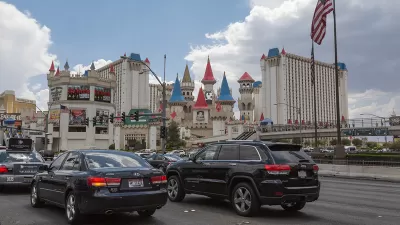Urban economist Joe Cortright examines the connection between gas prices and driving in the U.S. over the last two decades. Prices matter: increased gas prices results in decreased driving, providing the prices persist for the long-term.

"The relationship between prices and driving isn’t perfect and instantaneous," writes Cortright, director of Portland, Ore.-based City Observatory, for CityLab on Feb. 28.
People make decisions about where to live, how far they’re willing to commute to work, whether to own a car (or a second car), and whether to use various other modes (cycling, transit, and walking) on a long-term basis. But, especially over time, prices influence all of these decisions.
To prove his point, Cortright examines four distinct time periods from 2000 to 2018 based on the price level of gasoline. An interactive graph from the Federal Reserve Economic Data (FRED), maintained by the research division of the Federal Reserve Bank of St. Louis, illustrates the inverse relationship between gas prices and vehicle miles traveled (VMT) for this time period. Note that gas prices are not adjusted for inflation and that VMT is measured per capita.
Four distinct phases in the price of gasoline and the attendant patterns of American driving
- 2000 through 2004 (4 years): Era of cheap gas and rising VMT: "'[P]eak driving' in the U.S. was in June 2005, when Americans drove 27.7 miles per person per day. At the time, gasoline cost an average of about $2.13 per gallon," writes Cortright.
- Phase 2: 2005 to July 2014: (9+ years): Expensive gas era. "By 2013, the typical American was driving about 25.7 miles, more than 2 miles per person per day less than at the peak."
- Phase 3: 2014-2016 (2 years): Cheaper gas again. Gas prices began falling in July 2014. After OPEC met in Vienna on November 27 and decided that maintaining market share preempted stabilizing gas prices, prices plummeted. "In April 2014, gas prices averaged more than $3.70 a gallon, and people drove an average of 25.7 miles per day. Some 22 months later, in February 2016, with prices averaging about $1.75 a gallon, consumers were driving about 26.7 miles per day, about 4 percent more."
- Phase 4: 2016-2018 (2 years): A rebound in gas prices:
Over the past two years, gas prices have again trended upward, rising from less than $2 per gallon to nearly $3 per gallon. As they’ve done so, the growth in per-capita driving has slowed, and—once again—reversed. Vehicle miles traveled per person peaked in late 2017, and have been trending down again since then.
On March 3, the average gas price in the U.S. was $2.46 per gallon, according to AAA. The most recent data of vehicle miles traveled from the Federal Highway Administration's Traffic Volume Trends is for November 2018, showing a 0.3% increase compared with November 2017, which is also the same increase for cumulative travel for 2018. However, FHWA does not adjust for population growth.
Cortright's conclusion:
Sustained high prices for gasoline lead to real reductions in vehicle miles traveled, in pollution and in car deaths. If we price travel appropriately, consumers will make different decisions—ones that significantly reduce the social and environmental costs of car travel. Prices matter and should be at the heart of all of our efforts to cope with climate change and build stronger and safer communities.
Alternative perspective
"A brief analysis by the State Smart Transportation Initiative found a weak connection between VMT and gas prices, and a rather strong one between vehicle miles and urban density," wrote Eric Jaffe for CityLab in March 2012 (posted here).
Cortright's post is also available on City Observatory.
FULL STORY: The High Price of Cheap Gasoline

Study: Maui’s Plan to Convert Vacation Rentals to Long-Term Housing Could Cause Nearly $1 Billion Economic Loss
The plan would reduce visitor accommodation by 25,% resulting in 1,900 jobs lost.

North Texas Transit Leaders Tout Benefits of TOD for Growing Region
At a summit focused on transit-oriented development, policymakers discussed how North Texas’ expanded light rail system can serve as a tool for economic growth.

Using Old Oil and Gas Wells for Green Energy Storage
Penn State researchers have found that repurposing abandoned oil and gas wells for geothermal-assisted compressed-air energy storage can boost efficiency, reduce environmental risks, and support clean energy and job transitions.

Santa Barbara Could Build Housing on County Land
County supervisors moved forward a proposal to build workforce housing on two county-owned parcels.

San Mateo Formally Opposes Freeway Project
The city council will send a letter to Caltrans urging the agency to reconsider a plan to expand the 101 through the city of San Mateo.

A Bronx Community Fights to Have its Voice Heard
After organizing and giving input for decades, the community around the Kingsbridge Armory might actually see it redeveloped — and they want to continue to have a say in how it goes.
Urban Design for Planners 1: Software Tools
This six-course series explores essential urban design concepts using open source software and equips planners with the tools they need to participate fully in the urban design process.
Planning for Universal Design
Learn the tools for implementing Universal Design in planning regulations.
Ascent Environmental
Borough of Carlisle
Institute for Housing and Urban Development Studies (IHS)
City of Grandview
Harvard GSD Executive Education
Toledo-Lucas County Plan Commissions
Salt Lake City
NYU Wagner Graduate School of Public Service





























